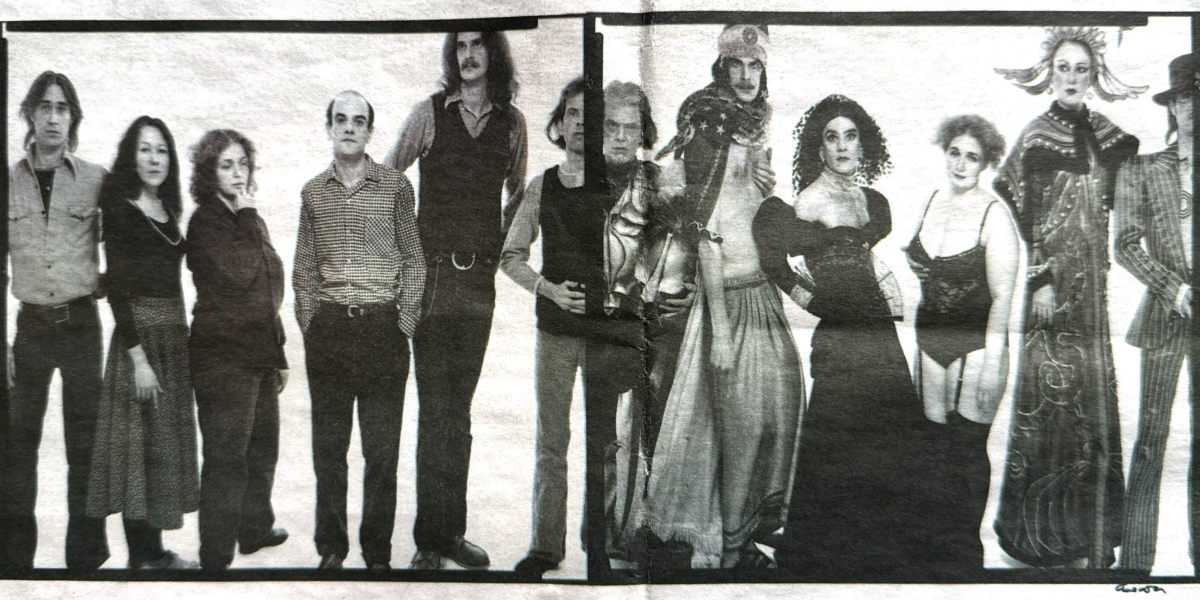Feature image courtesy of the LGBTQ+ NYC Artists Archive Project, photos by Richard Avedon, gifted to Lola Pashalinski

The Ridiculous Theatrical Company: Bill Vehr, Black-Eyed Susan, Lola Pashalinski, Charles Ludlam, John Brockmeyer, Jack Mallory
I arrived at BAM to see their new exhibition highlighting the LGBTQ+ Artists Archive Project. But first, BAM’s director of archives, Sharon Lehner, insisted I see the theatre.
“What I love about this theatre is it’s partly found as is and partly created through stagecraft,” Sharon told me, before explaining its history. The Harvey Theater began as a playhouse in 1904, then it was converted into a movie theatre, then it was abandoned, and, finally, it was rediscovered by legendary director Peter Brook. Today, the walls still look worn, the ceiling medallion faded; a restoration that aimed to emphasize rather than erase its history.
But that’s the stagecraft Sharon mentioned. The medallion is original, but the worn walls were created. The theater itself is a set. It’s meant to give the impression of age even though some of its most prominent signifiers are pure design.
This is the magic of theatre. Where a play is shown is as integral to the experience as text or who is cast in the lead. Theatre is an experience, one that changes every night, and certainly changes production to production of the same work. This also makes its history difficult to preserve.
“Archiving performance is a theoretical notion,” Sharon admitted. “How can you archive something ephemeral that happened in the past? It’s always a lack, it’s always a pointing. We get that and we embrace it.”
BAM’s extensive performing arts archive makes it a fitting home for the launch of the LGBTQ+ NYC Artists Archive Project, a collective of downtown NYC artists who came to prominence in the 80s and 90s who are striving to share their archives and change the archival process for others.
For now, that means an exhibition at BAM Strong’s Rudin Family Gallery, a collection of photographs of the artists with brief bios, as well as a wall of video. It is not a display of their archives — that work has yet to be done — it’s, to steal Sharon’s word, a pointing toward possibility. It’s an education for those of us who may not know some of these names despite their importance and a fundraising plea to make complete archives a reality.
At the gallery, their mission is outlined on a newsprint handout that’s as much an artistic nod to the past as the theatre next door. (Sharon noted to me that newsprint is terrible for archival material, but that it does have a cool effect for these purposes.)
“In recent years, too many avant-garde artists have died leaving the prohibitively expensive task of caretaking their legacies to ill-equipped friends and family members with devastating results, erasing contributions and cultural history,” the handout reads. It then goes on to outline the planned archival process.
“Some of the artists here have already worked in interesting hybrid forms between performance and archives, so they were thinking it would be good to use a performance venue to launch the project,” Sharon explained. She also noted the diversity in styles and forms among these artists. Beyond being queer, downtown NYC artists from the same general time period, there are few other similarities. This is evident even from the small exhibit and samples of footage.
The artists involved in the collective are Ain Gordon, Five Lesbian Brothers, Ishmael Houston-Jones, John Kelly, Richard Move, Lola Pashalinski, and Carmelita Tropicana. If you’re not in New York and can’t view this exhibit, you can — and should — read about each of these artists and their accomplishments at the LGBTQ+ NYC Artists Archive Project website.
Queerness is in a perpetual state of discovery by the mainstream, but queer people and queer artists have always been around. This project is a reminder of the importance of preserving our history. It’s a testament to the power of collective and a reminder that sometimes as queer people we have to believe in our own importance before we can get the attention of others.
“History is remembered if it’s valued and supported,” Sharon said. “And the more voices we archive the better.”
The LGBTQ+ NYC Artists Archive Project exhibition is showing at BAM Strong through the end of June.


